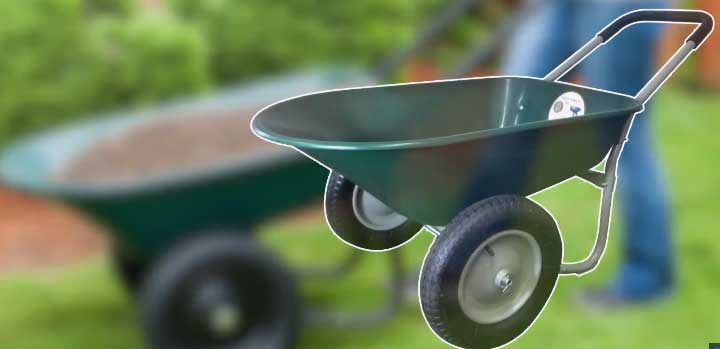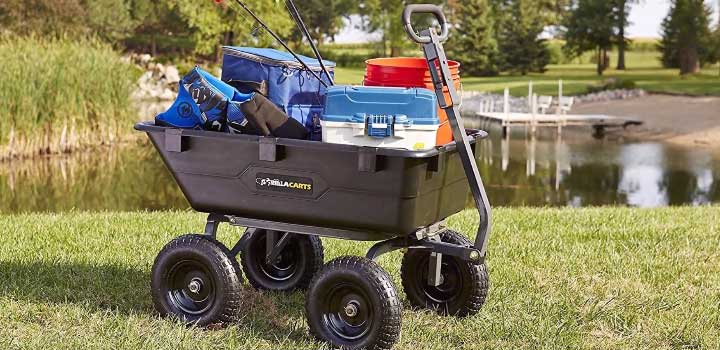If you work on some DIY project in your yard and dig soil, you will need some wheelbarrows to remove topsoil or mulch and continue working.
But how many wheelbarrows are in a yard of soil, and how would you know? Well, today we’re going to help you find the answer. Read this write-up to know all the details.
What Is a Cubic Foot in Wheelbarrow Measurement?

Mainly, the yard is used to measure land in gardening and landscaping. A cubic foot signifies the volume of soil, sand, gravel, or mulch.
Therefore, when you see the measure of wheelbarrows, they are obviously in cubic feet. For example, 2 cubic feet means 2-feet cube volume, and this amount of load will fit in a wheelbarrow.
All of the wheelbarrows are produced by calculating their volume in cubic feet.
Why Is the Measurement in Cubic Foot?
Using cubic feet when you are about to landscape your yard is quite helpful. But most of us feel a bit confused when calculating the wheelbarrows in cubic feet.
If you can understand the measure, it will be easy for you to know how much coverage will fit your supplies.
But remember, the cubic foot is the measure of volume (size), not weight. So, there will be a weight difference in 2 cubic foot soil and a similar volume of concrete.
The cubic foot measure can explain depth, like how deep you want to dig or already dug. You can also tell the number of dump trucks you need to remove the soil from your yard. It’s pretty handy if you are in a landscaping company.
Number of Wheelbarrows Loads in Cubic Yard
You already know the number of wheelbarrows is calculated in cubic feet. Therefore, if you know their loads, you will know the total amount of soil it will carry. checkout the best soil for yard.
A 2 cubic foot wheelbarrow can carry 13.5 loads. It means that for a single cubic yard, you have to refill the wheelbarrow 14 times. Therefore, it can hold less amount of soil at a single time.
On the other hand, a 3 cubic foot wheelbarrow with 9 loads means it has to refill 9 times for a single cubic yard.
When the wheelbarrow size increases (4,5,6 cubic feet), the refill times decrease gradually (6.8, 5.4, 4.5 times of refill). But they are often used in gardening or DIY projects in the yard.
The 2 and 3 cubic foot wheelbarrows are easy to handle and drive. That’s why they are popular as they can be used anywhere.
But if you are looking for heavy-duty work in landscaping, you will need 3 to 6 cubic foot wheelbarrows. Otherwise, the calculations will be messy along with the outcome.
Types of Wheelbarrows
There are different varieties of wheelbarrows in the market, and each has individual sectors like gardening, landscaping, construction, etc.
On a rough-cut, there are mainly two types of wheelbarrows: standard wheelbarrows and contractor wheelbarrows.
Standard Wheelbarrows
Again, the standard wheelbarrows are of two types: shallow trays and deep trays.
The shallow trays are suitable for gardening and landscaping as they are 2 cubic foot size. You can efficiently perform your DIY projects in the yard and use a shallow tray to carry topsoil.
The deep trays are pretty much the same but a bit different in height and weight capacities. That’s why they are 3 to 6 cubic feet.
Contractor Wheelbarrows
They are not much popular because of their massive size and weight but are perfect for heavy-duty works. You can use contractor wheelbarrows for building construction as they have 6 to 10 cubic foot capacity.
How Can You Measure the Number of Wheelbarrows and Their Capacity?

To measure the number of wheelbarrows, you need to know their volumes in cubic feet and weight capacity.
First, you have to measure the flat base and slope of the wheelbarrow and put the dimension in the formula. Measure the surface area and height of the flat surface and multiply them to get cubic capacity.
Then use the three dimensions from the slope area to get the cubic volume. If you sum up both volumes, you will get the actual volume of the wheelbarrow.
Now, since you know the cubic foot of a wheelbarrow, you can calculate the number of refills. And at the end, you can tell the number of wheelbarrows and the amount of soil you have removed.
Should You Get Help for the Measurement?
If you are new at calculating the measurement of wheelbarrows, you may mess up the calculation. Your mistake will damage the whole planning, and sometimes it may affect the budget if you are in a landscaping company.
Therefore, it’s best for you to get help from an expert or some other landscaping company. You can even learn how to calculate the number of wheelbarrows and the plan from them.
So, How Many Wheelbarrows Are There in a Yard of Soil.
Out of several wheelbarrow variants, the 2 cubic feet and the 3 cubic feet are the most popular ones for any loads of soil work. The 2 cubic foot wheelbarrow can carry 13.5 loads (approx. 14) for a single cubic foot.
But the 3 cubic foot wheelbarrow has a low capacity of carrying loads (9 times of refilling loads). The 4, 5, and 6 cubic feet wheelbarrows have higher load capacity.
Bottom Line
Planning and calculation are crucial factors for works like DIY projects, landscaping, gardening, etcetera. So, knowing the number of wheelbarrows that are used in your work is also essential. After reading the article, we hope you can tell how many wheelbarrows in a yard of soil.
Even if you don’t know the cubic foot of the wheelbarrow, use the mentioned technique to measure yourself. So, calculate calmly and execute your work with perfection!
Our Recommended Recourses: